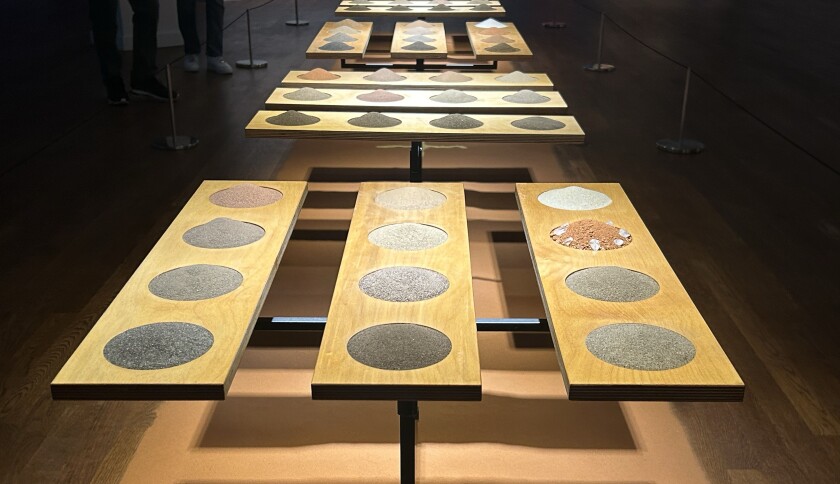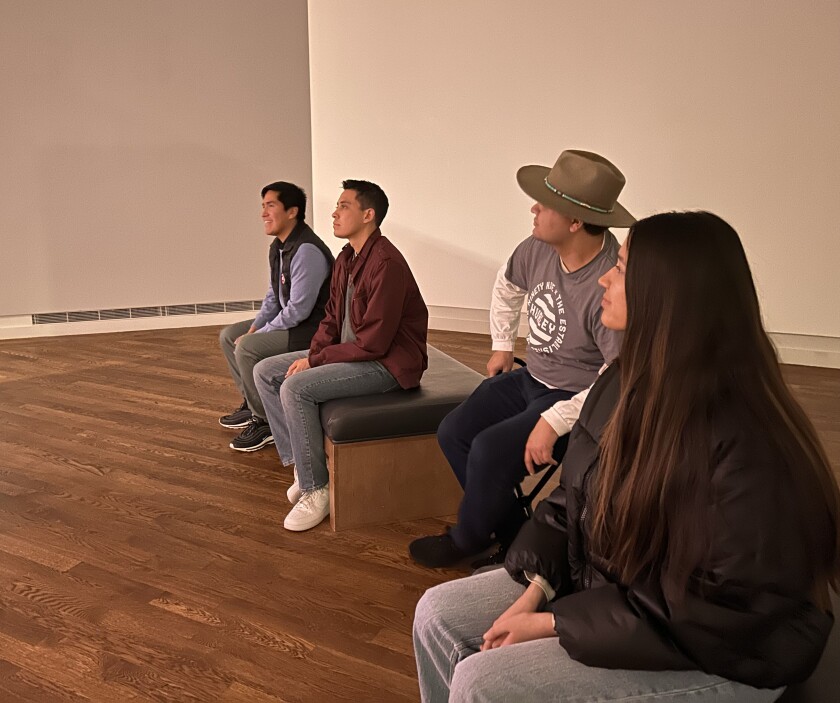
Native American BYU students who toured the “Kéyah: Our Home” exhibit by Eugene Tapahe recognized and connected with shared elements of their culture.
A new art exhibit opened at the BYU Museum of Art on Jan. 24. The exhibit features the work of Eugene Tapahe, a Diné (Navajo) artist. Tapahe used natural materials to showcase various elements of his culture. His work embodies Native American values, including appreciation for Mother Earth and sacred land.
The main attractions included a display of soil samples from all over the United States and Canada collected by individuals from various tribes. A video showcased another of Tapahe’s works, a dirt painting created in Monument Valley, Arizona. These displays were familiar to the students who participated in the tour.
“It felt like a piece of home,” William Wayne said.
Wayne, who grew up in Arizona, said that the soil exhibit reminded him of his childhood experience of playing in the dirt. After watching a video of the creation of a dirt painting by Eugene Taphe, Wayne admitted he too had made images in the dirt near the reservation where he lived.
“I actually did stuff like that as a kid,” Wayne said. “Just patting down the dirt to make little paths. That’s just something that someone like me would have done.”

Joseph Namingha, from the Zuni Pueblo, connected with the exhibit for different reasons.
“Just being able to see the exhibit here at BYU by Eugene Tapahe is pretty inspiring,” Namingha said. “Just to see his work and person, but also to know how renowned and well-received he is, not only throughout the U.S. but throughout the world.”
Namingha is a member of the Tribe of Many Feathers club at BYU. He was first introduced to the club by his father who was also a member while attending BYU. He has loved his experience connecting with other Native American students who share similar backgrounds. Namingha noted his gratitude for Tapahe’s exhibit at BYU.
“You see how his journey came through BYU,” Namingha said about Tapahe. “The rich heritage and connection that BYU has with Native American students and being able to have that connection and support to continue to grow and develop talents.”
Ryan Tsosie, whose father is Diné, said that his journey to understand more about his heritage started at BYU.
“At BYU I had the chance to join the multicultural group Living Legends to really express myself as a Native American, as Diné," Tsosie said.
Tsosie learned more about his culture through these performances. He said that he had a particularly meaningful experience on tour performing on Native American reservations.
“They just love the Native sections and their performances and how impactful it was. Especially for the kids to be like, ‘hey, there’s other people who are like me,' going off to college and making a name for themselves,” Tsosie said. “We leave our little impacts on them there.”
Tsosie continues to connect with his heritage through connecting with other Native American students at BYU. He felt that it was a powerful expression to be able to show these kids that they can express their culture as they grow up.
Jaclyn Hollingsworth is from American Fork, Utah but this exhibition reminds her of Sheep Springs, New Mexico where her mother is from. A place Hollingsworth described as “home" because of its link to her heritage.
“I feel like it’s not just for Native Americans to be able to have this experience,” Hollingsworth said. "Anybody can feel that way. They can grow up somewhere different but their history can tie them back to somewhere else that they can view as home."

The exhibit runs from Jan. 24 through April 26, 2025. More information can be found on the BYU Museum of Art website.